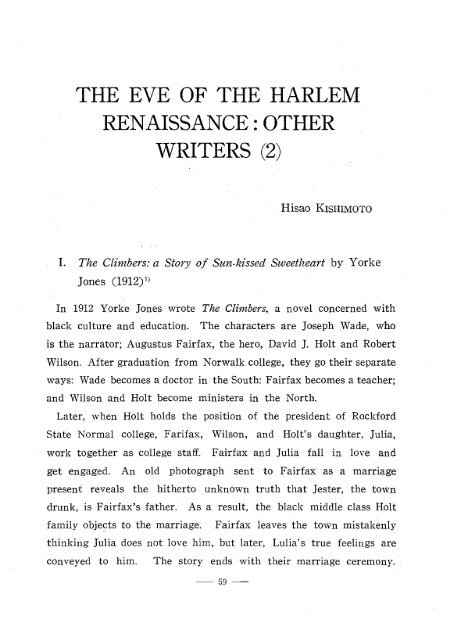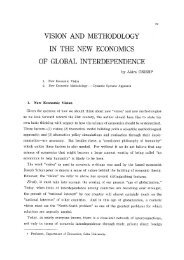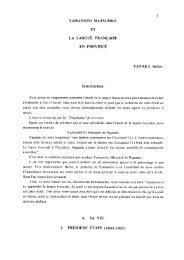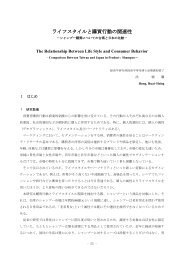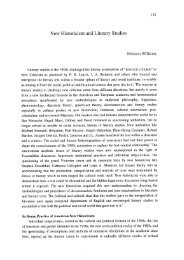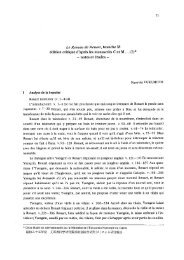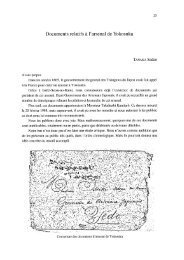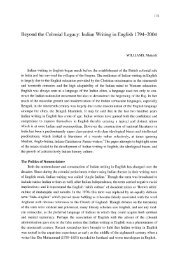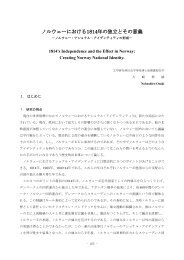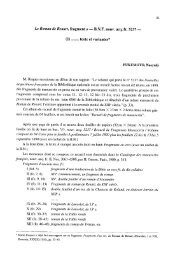Create successful ePaper yourself
Turn your PDF publications into a flip-book with our unique Google optimized e-Paper software.
THE EVE OF THE<br />
RENAISSANCE :<br />
WRITERS<br />
<strong>HARLEM</strong><br />
<strong>OTHER</strong><br />
(2)<br />
Hisao KISHIMOTO<br />
I. The Climbers: a Story of Sun-kissed Sweetheart by Yorke<br />
Jones (1912)1)<br />
In 1912 Yorke Jones wrote The. Climbers, a novel concerned with<br />
black culture and education. The characters are Joseph Wade, who<br />
is the narrator; Augustus Fairfax, the hero, David J. Holt and Robert<br />
Wilson. After graduation from Norwalk college, they go their separate<br />
ways: Wade becomes a doctor in the South: Fairfax becomes a teacher;<br />
and Wilson and Holt become ministers in the North.<br />
Later, when Holt holds the position of the president of Rockford<br />
State Normal college, Farifax, Wilson, and Holt's daughter, Julia,<br />
work together as college staff. Fairfax and Julia fall in love and<br />
get engaged. An old photograph sent to Fairfax as a marriage<br />
present reveals the hitherto unknown truth that Jester, the town<br />
drunk, is Fairfax's father. As a. result, the black middle class Holt<br />
family objects to the marriage. Fairfax leaves the town mistakenly<br />
thinking Julia does not love him, but later, Lulia's true feelings are<br />
conveyed to him. The story ends with their marriage ceremony.<br />
59 -----<br />
-----
Yorke Jones introduces Fairfax as follows:<br />
My risibles were touched by the contrast between his appearance<br />
and high-sounding name. Augustus Fairfax! He was smooth-<br />
black, tall and thin—even to gauntness. As nervously restless<br />
was he as a blooded racer ... he was born of slave parents;<br />
brought North ... he had made good progress in his studies .. .<br />
he became the college butt of fun and was thought to be very<br />
light hearted because he seemed so amusing ... Because he present<br />
was new and the future bright, Fairfax was hopeful; though<br />
not so light hearted as he seemed comical ....<br />
Fairfax's race are America's butt of fun. They, too, are thought<br />
to be very light hearted because they seem aumsing; but while<br />
the black man is hopeful (because his present is new and his<br />
future full of promise), yet it is a grave mistake to imagine that<br />
the child of Ham feels free of care, because, to his brother in<br />
white, he seems amusing.2)<br />
Regretably, Jones' characterization of Fairfax is the very stereotype<br />
which whites had of blacks at . that time and this passage, like the<br />
novel as a whole, is flawed by repetition. Hugh M. Gloster has stated<br />
that this novel "lacks the restraint of Johnson's The Autobiography of<br />
an Ex-Colored Man. Like Booker T. Washington, Jones thinks highly<br />
of industrial education. Mr. Holt insist:<br />
... the State's education of the Negro is not a gratuity, it is<br />
the Negro's right. The child of the wage-earner has the same<br />
right to State education that the capitalist's child has.4)<br />
The author echos Washington's views on this issue and futhermore,<br />
----- 60 -----
insists that " ... Negroes money will buy the same fine things that<br />
white folk's money will ... Yet they (southern people) keep themselves<br />
in such a frenzy about social equality or rather social intercourse.... "5)<br />
He points out two reasons for this: first, "because the dread of social<br />
equality is baseless. Negroes no more want to associate socially with<br />
white people than white people want to mingle socially with Negroes!<br />
Secondly, this baseless fear of social equality betrays the people of the<br />
South into many, many injustices toward the once enslaved race.")<br />
In spite of these pessimistic remarks, Jones is extremely optimistic<br />
in his characterization of blacks and in the resolution of the novel.<br />
The reason for this is his black middle class ideals which are also<br />
expressed in the works of preceding black novelists.<br />
In conclusion, this novel is a statement of the merits and demerits<br />
of the black middle class and the sufferings wrought by pressure from<br />
the white South through the medium of a love story.<br />
II. The Conquest (1913) and The Forged Note (1915) by<br />
Oscar Micheaux<br />
Oscar Micheaux(1884-1951) published three novels before the Harlem<br />
Renaissance: The conquest: the Story of a Negro Pioneer in 1913, The<br />
Forged Note: a Romance of the Darker Races in 1915: The Homesteader<br />
in 1917. (In this article there is no commentary about The Homesteader<br />
because the book was unavailable.)<br />
According to Bruce Kellner's The Harlem Renaissance; a Historical<br />
Dictionary for the Era, Oscar Micheaux is introduced as a black<br />
pioneer film producer:<br />
This son of former slaves began his career as a pullman car<br />
porter, but when he saw an advertisement for cheap land on an<br />
61 ----<br />
----
Indian Reservation, became intersted in farming and ranching and<br />
within five years he had expanded his South Dakota homestead.<br />
He lost his land in his twenties because of his inlaws' dishonesty,<br />
so he became a writer for pulps, using his own experiences for<br />
subject matter. Micheaux had a talent to sell his books.<br />
When the Lincoln Motion Picture Company wanted to film<br />
Micheaux's The Homesteader he refused because his proposal to<br />
direct his film was not accepted; instead he founded the Micheaux<br />
Film Corporation. Many films followed The Homesteader, all<br />
filmed for exclusively black audiences. Micheaux used actors from<br />
Lafayette Players Stock Company in the beginning—Evely Preer,<br />
for example, played Agnes in The Homesteader—but soon, he had<br />
developed his own stable of performers, usually light skinned and<br />
usually in emulation of Hollywood stars such as Lorenzo Tucker.<br />
A few of the films are noteworthy: Within Our Gates (1920) is.<br />
about lynchi,ng; in Birthright (1924), a black Harvard student returns<br />
to his southern hometown to start a black college, only to be<br />
opposed by both black and white members of the community;<br />
Paul Robeson played in Body and Soul; and The House Behind the<br />
Cedars (1923) was based on Charles W. Chesnutt's novel.<br />
None of Micheaux's films had any critical acclaim but he must<br />
have been an imposing figure, traveling arotInd the country from<br />
movie house to movie house in flashy automobiles, wearing big<br />
hats and full-lenght fur coats. He always operated on a shoestring,<br />
and bankruptcy caught up with his extravagant risks in 1928. He<br />
reorganized the following year, largely with backing from white<br />
investors, but during the thirties the criticism of his work grew<br />
stronger because of his insistence on light-skinned performers and<br />
---- 62 ----
depictions of stereotypical behavior.7)<br />
Looking at Micheaux's careers, there seem to be no duobt that The<br />
Conquest and The Forged Note are autobiographical novels. Oscar<br />
Davereaux, the hero in The Coquest (Devereaux suggests the author's<br />
name was Oscar Micheaux), was the bright but lazy son of a rich<br />
black farmer. Using the excuse that he must learn business his<br />
parents throw him out of his home at the age of seventeen. He<br />
changes jobs frequently seeking to better his situation: he works in a<br />
coal mine and in a coal chute, as a shoe shine boy, porter, etc. He<br />
saves considerable money from his wages and tips as a porter, and<br />
when part of an Indian reservation is put up for sale, he manages to<br />
obtain it for 2500 dollars. After saving more money working as porter<br />
he turns to homesteading. Overcoming numerous struggles he climbs<br />
the ladder of greater and greater success. During this time he falls<br />
in love with Jessie, struggles with the developers who are trying to<br />
build a railroad, falls in love with a Scotch girl—concealing his<br />
engagement to Jessie—marries Miss Orlean, the daughter of Rev.<br />
McCraline and then divorces her.<br />
This novel was dedicated to Booker T. Washington Micheaux states<br />
in the introduction that "this is a true story of a negro who was<br />
discontented and the circumstances that were the outcome of that<br />
discontent." Although this is "a true story," it is also happens to be<br />
the Black version of the American Dream:<br />
There are two distinct factions of the negro race, who might<br />
be classed as Progressives and Reactionaries. somewhat like the<br />
politicians. The Progressives, led by Booker T. Washington and<br />
with industrial education as the material idea, are good, active<br />
63 -----<br />
-----
citizens; while the other class distinctly reactionary in every way,<br />
contend for more equal rights, privileges, and protection, which is<br />
all very logical, indeed, but they do not substantiate heir demands<br />
with any concrete policies; depending largely on loud demands,<br />
and are too much given to the condemnation of the entire white<br />
race for the depredations of a f ew. 9<br />
This outlook is anti-DuBois aind pro-Booker T. Washington.<br />
Micheaux's second novel, The Forged Note, is a continuation of The<br />
Conquest. His experience of selling books is treated as a love story.<br />
Sydney Wyeth, novelist, sells books by himself. The story starts with<br />
Sydney and Mildreds encounter o,ne year prior to his strange sickness<br />
when he is selling books in Cinncinatti. At first sight she becomes<br />
the central person in his life. With his writer's intuition, he reads<br />
the dark fortune in her face, however, he can do nothing for her and<br />
leaves for another town. She sets off to search for him selling books,<br />
but after many struggles to find him.<br />
One day a strange malady befalls Sydney and Mildred takes care<br />
of him in the hospital. During the next few months she takes over<br />
his business and makes it a success. When he recovers from his<br />
sickness, he leaves town. But he realizes his love for her, comes<br />
back and confesses his love to her. But then she leaves town suddenly.<br />
In the final stage Sydney gets information at an ex-slave market that<br />
Mildred has become a nun. He waits for her at the market and, at<br />
last, he is able to meet her again.<br />
This love story contains some sub-themes, such as the social problems<br />
confronting blacks. In Effingham at that time 80% of all murders<br />
was among the black population. Sydney points out, however, that<br />
64<br />
-----
elite blacks do not worry about such problems:<br />
And, as he met the more elite, he was surprised that they paid<br />
so little attention to the condition of the masses. Murder, as we<br />
have seen, was an establised habit ... In other words, "They never<br />
worries. "10)<br />
Miss ]Palmer who helps to sell his books says:<br />
These Negro in Effingham are nigga's proper. They think noth-<br />
ing about reading and trying to learn something, they only care<br />
for dressing up and having a good time.I")<br />
After searching for the sources of the problem Sydney discovers the<br />
the reason for the black man's falling: "his people were the victims<br />
of liquor and gaming, and this was the result of ill training, ignorance,<br />
and lack of civic observation. "12 In conclusion, he enumerates the<br />
concrete causes of the problem:<br />
This [library ] was not open to colored people ... It is a distress-<br />
ing condition which the state is facing. A library will, in time,<br />
have a marked effect upon existing conditions ... In Effingham,<br />
there are perhaps a half dozen small and large parks, and all<br />
for white use exclusively. During the hot days of the long sum-<br />
mer, black people must roast in their stuffy little homes, perhaps<br />
a fourth of which face alleys. Black children have no place to<br />
play, no place to exercise their little bodies, or give free vent to<br />
their desire for child play. Crime, therefore, is their greatest<br />
environment.13)<br />
Considering the situation Sydney is resentful that "more than a<br />
hundred churches never encouraged the people to read anything but<br />
65 ----
the Bible."") He criticizes teachers, preachers, and even the best<br />
people for their lack of concern with crime committed by blacks.<br />
Strangely, the title of the novel, The Forged Note is a mere supple-<br />
ment. Mildred Latham a mystery girl is foreshadowed by a man<br />
who threatens her. Everytime he appears she changes her address.<br />
Sydney comes to know about this situatidn from a person he meets<br />
during his business trips. It seems that Mildred's father, an ex-<br />
minster, pocketed money belonging to the church to become bishop.<br />
A rich merchant, who know of the theft, forced Mildred to get married<br />
him. Although the title seems to indicate otherwise, the situation<br />
concerning the forged note is the incidental to the main story, which<br />
is actually a romance with peripheral environmental concerns.<br />
III. Redder Blood (1915) by Williams M. Ashby"'<br />
This is a melodramatic novel about a lady who conceals her identity<br />
marries a rich man, incurs a catastrophy upon the revelation of her<br />
identity and then resumes a happy life.<br />
The first scene takes place in Central Park in New York when a<br />
wealthy man named Stanton Birch falls off his horse and recieves a<br />
serious wound. Attracted by beauty and kindness of Miss Zelda<br />
Marston, his nurse, he marries her. They have a son and lead a<br />
happy life.<br />
Mr. Birch hires a new chef named Leon, who is an old friend of<br />
Mrs. Birch and knows that she has black blood. He threatens her to<br />
reveal her secret, and as a result, she become mentally and physically<br />
exhausted. Finally, Leon reveals to Mr. Birch . that his wife is a<br />
black. Mr. Birch becomes upset and leaves for Europe.<br />
66 -----<br />
-----
One year later Zelda settles in New Jersey where she spends her<br />
days doing charity work. Mr. Birch, who is still traveling in Europe,<br />
is unhappy because he cannot forget her. One stormy evening as Zelda<br />
is playing her husband's favorite tune on the piano her husband<br />
visits her. William M. Asbhy states as follows:<br />
The book does say, however, — and, I hope, strongly, -- that<br />
where two persons love each other deeply neither custom, nor<br />
convention, nor law are great enough barriers to keep them<br />
apart. ..16)<br />
This is clearly the theme of this novel. The fundamental idea is<br />
that:<br />
.... we are all the same in essence ... but in any case the<br />
basis, the essence, the one little cell, that makes one human being<br />
has the same fundamental parts that make another.17)<br />
I,n the beginning both Mr. and Mrs. Birch are idealistic. Mr. Birch<br />
thinks that the Negro problem "is not a Negro problem, it is not a<br />
Southern problem, it is a human, live American problem. "18) But<br />
when Mrs. Birch's identity is revealed he changes his stand. She cries<br />
out to her husband, "you cannot build up a world of love with color<br />
as its basis. Love is not that sort of thing."") He rebukes her, "Do<br />
you think I could mix my pure blood with common stock?"24> Their<br />
son Adrian accuses his father of prejudice and sides with his mother:<br />
You are moved by unjust hate; you think the thoughts of fifty<br />
years .ago, mine are of to-day, newer thoughts ... "My blood is<br />
redder, redeer blood,—the corpuscles of which are not hate, every<br />
67 ----<br />
----
prejudice, but respect and kind feeling for others. "211<br />
The word "newer thought" or "redder blood" are the key concepts<br />
in the novel. A year later, when Mr. Birch meets Mrs. Birch again,<br />
he says, "Our boy was right. Love is the only thing in the world<br />
worth while. It's God's greatest gift to men. "22) This is the answer to<br />
questions posed by the novel. The simplistic solution of the novel,<br />
however, cheapens it and makes it seem melodramatic.<br />
IV. Lillian Simmons or the Conflict of Sections (1919) by<br />
Otis M. Shackleford 23)<br />
This is a love story between Lillian Simmons, a Northern black<br />
belle, and Charles Christopher, a Southern black youth who is working<br />
in the North. One day Charles quarrels with George Simmons, Lill-<br />
ian's brother, about blacks. As a result George instigates members of<br />
his group to drive Charles out of town with the accusation, "the<br />
Southern niggers spoiled our privileges. "24) Lillian, who has been the<br />
object of Charles' devotion since they first met, realizes the gravity<br />
of the situation and persuades Charles to leave town.<br />
After the trouble George resigns from his job with the city and<br />
leads an unstable life. Because of George's bad reputation his father<br />
also loses his good standing and Lillian cannot even get a job. The<br />
family fortune steadily declines.<br />
Three years later, after Charles has saved a considerable amount of<br />
money, he decides to return to town to start a business. Just as he<br />
arrives back in town Lillian is about to go South to teach. Seeing<br />
each other only briefly, they have to part.<br />
Charles' business is prosterous, but one night someone sets fire to<br />
his grocery. On the testimony of a witness, George is arrested on<br />
68 ----<br />
----
an arson charge. This marks a turning point in their relationship.<br />
At the end of the story Charles gets married to Lillian and George,<br />
who has mended his ways, forms a company together with Charles<br />
called Charles and George Company.<br />
The subject of this novel is interracial conflict, that is the difference<br />
between the Southern and Northern stance toward blacks. During a<br />
quarrel with Charles about Southern blacks George expresses his anger:<br />
... prejudice is rapidly growing all over this country. It is<br />
taking or has taken deep root in your city. This is inevitable<br />
and it would have come sooner or later regardless of the conduct<br />
of these so-styled bad Southern "niggers." ... You had better<br />
carry your Southern ideas and prejudices out of this town. We<br />
don't need you to teach us any lessons. And any advice to you is<br />
to "beat it."25)<br />
In answer to George's remarks, Charles retorts as follows:<br />
Your Northern people have yet to learn this lesson, ... that<br />
white people are white people, that blood is thicker than water,<br />
that the racial instinct will assert itself. That one bad negro<br />
connot spoil the privileges of a community of good negroes,<br />
unless the prejudice in the hearts of the other race is aroused.26<br />
Shackelford maintains that the ongoing quarrel between George and<br />
Charles, Lillians' struggles resulting from this friction is the conflict<br />
of the sections indicated by the sub-title of the novel. Moreover, he<br />
indicates that the reconcilation between George and Charles leads to<br />
"harmony and progress ,":<br />
A Business League has been organized with Charles Christopher<br />
69<br />
----
as its president. And such harmony and progress was never<br />
before known in this city among the colored people.<br />
Northerners and Southerners view life through the same glass<br />
in this city. They are united by the ties of friendship, by ties of<br />
business and the ties of matrimony. It is difficult to break such<br />
a combination.27<br />
He added that the ties of friendship, the ties of business, and the<br />
ties of matrimony are "converted to the idea of . Negro enterprise,<br />
even if it does invite segregation. "28? Shackleford insists that "separate<br />
schools are not harmful, but are a positive benefit to the race. They<br />
furnish employment for the worthy boys and girls of the race and<br />
are inducements for them to pursue the higher courses of learning<br />
and to strive to excel in them "29) This thought accords with the<br />
fundamental idea of Booker T. Washington expressed in his address:<br />
"<br />
. If need be ... interlacing our industrial, commercial, civil, and<br />
riligious life with yours in a way that shall make the interests of<br />
both races one ... There is no defence or security for any of us except<br />
in the hightest intelligence and development of all. "30)<br />
Even the characterization of the main characters seems to be in<br />
accord with Washington's aim. The hero Charles is described as fol-<br />
lows:<br />
... his thoughts were pure and his ideals were lofty; that he<br />
had a high aim in life; that it was this high aim which had led<br />
him on step by step until he had completed his education in one<br />
of the Southern Colleges.31)<br />
On the other hand George, who is handsome with light brown skin,<br />
is characterized as follows:<br />
70
He also had an air of freedom and independence about him<br />
which is usually in evidence with Northern born and Northern<br />
educated colored people. His training and high spirit showed per-<br />
ceptibly when he spoke . . .32)<br />
Beautiful, healthy, vigorous, and optimistic Lillian is "a girl whose<br />
training had not been neglected in any line. Cooking, sewing, and<br />
piano, playing were her accomplishments. "33) Both George and Lillian<br />
appear to be perfect person. It almost seems as if an actor and an<br />
actress are portraying love and the friendship between the South and<br />
the North in a play produced by Otis M. Shackleford at the Booker<br />
T. Washington Theatre. According to the author, however, this novel<br />
is merely a love story.<br />
V. The American Cavalryman : a Liberian Romance (1917)<br />
by Henry F. Downing. 34)<br />
Calvert, a wealthy white man living in New York, has two secrets.<br />
The first is that he had a daughter with a native woman in Africa<br />
twenty year ago. The second is that he has a sister who is a negress.<br />
The novel is the story of his sister's son, Paul Dale, and a Liberian<br />
girl named Lupelta.<br />
Paul is a captain serving the Liberian president. One day he rescues<br />
a native girl Lupelta from Chief Lodango and falls in love with her.<br />
He educates her and teaches her to be a cultivated lady. On another<br />
occasion he helps a young inbunda tribe member, Whreabo, from being<br />
abused by Muffy, a relative of the president. This provokes Muffy's<br />
hostility. With the president he plots to entrap Paul in order to win<br />
the princess hand, dispatching him to a dangerous district. When<br />
71
Lupelta and princess Hulda, who also loves Paul, go on a picnic.<br />
Lodango kidnaps them on the orders of Muffy. Whreabo, who wit-<br />
nessed the scene informs Paul of the news. After many difficulties<br />
Paul rescues them from the precarious situation. with the help of the<br />
Chief Mwambo. Just before he rescues them Paul receives a letter that<br />
says Lupelta is a white.<br />
The last scene is a happy one of the Dales in New York three years<br />
later. Princess Hulda is now Paul's wife. It turns out that Lupelta<br />
is actually Mr. Calvert's daughter who has been missing for twenty<br />
years.<br />
According to Hugh M. Gloster, this novel was dedicated to "the<br />
Spingarn brothers," that is, Arthur B. Spingarn (vice-president of the<br />
National Assoiation for the advancement of Colored People) and Joel<br />
E. Spingarn (the chairman of the board). However, the dedication is<br />
not found in the AMS Press version printed in 1973, which is reprinted<br />
from the 1917 edition. This is a romance with virtually no ideological<br />
concerns except the minor one of the development of the agricultural<br />
resources of Liberia. Upon returning to the Unite States, Paul devotes<br />
all his efforts to this concern. He makes the following statement to<br />
his wife:<br />
The so-called leader, who now fatten on the State, doubtless will<br />
wish me further; but the majority of the people will rejoice.<br />
Anyhow, if I succeded, the country will be saved from being<br />
absorbed by some European power, and that will be something<br />
gained. 35)<br />
This statement lacks concrete aspects arid this is the limitation of the<br />
novel as a whole.<br />
----- 72 ------
VI. The Immediate Jewel of His Soul (1919) by Herman<br />
Dreer36<br />
William Smith is a brilliant, active youth who was the president<br />
of a young people's circle and a member of a choir. After graduating<br />
high school he works on his uncle's plantation in the south. When<br />
he witnesses a lynching scene by a white mob there, he decides to<br />
become a minister to save black people.<br />
He graduates college, attends a theoligical seminary, and then is<br />
ordained to be a minister. The speech he gives at his appointment<br />
ceremony arouses antipathy among the clergy present. Another re-<br />
mark made at the Ministrial Conference worses the situation so he is<br />
not even allowed to preach. Moreover, his chances to be become a<br />
lawyer or teacher are also deferred because of his subversive thoughts.<br />
Finally, after many long struggles he is permitted to become minister.<br />
At a party Reverend Smith sees his old friends. Thelma Haskell<br />
and Susan Lee, who are in love with him. Smith confesses his love<br />
to Susan to whom has been attracted since high school.<br />
The next spring Smith buys a 600-acre farm about 80 miles from<br />
Seaton where he builds his home, church, and an experimental farm.<br />
The farm is operated by both blacks and whites.<br />
Susan, who runs a music school, is awaiting Smith's marriage<br />
proposal, but when she visits Smith's farm he is too busy to talk<br />
with her. Thelma, who is more agressive than Susan, also visits<br />
Smith's farm i;n an attempt win to his heart.<br />
The .. success of Smith's farm is threatening to whites. Moreover,<br />
his conversion of many good black Christians arouses the displeasure<br />
of wine dealers. As a result, there is an increase in the tension bet-<br />
73 -----<br />
-----
ween whites and blacks. As soon as Thelma becomes aware of this<br />
problem she hurries to the farm to organize for self-defence. When<br />
Susan arrives at the farm there is tension between Thelma and herself.<br />
Cocurrent with this love triangle inside the farm is in the explosive<br />
situation instigated by the white mob outside. Succumbing to the<br />
tension Susan faints. While she is unconscious, Reverend Smith re-<br />
solves the crisis with the help of the mayor and the collaboration of<br />
sensible whites. When Susan recovers she finds that everyone on the<br />
farm is cerebrating. She realizes that Thelma has won the reverend's<br />
heart and she leaves the farm alone.<br />
Reverend Smith's ideas about blacks are expressed at the appoint-<br />
ment where he is appointed minister. "So much white blood was mixt<br />
with ours during the two hundred fifty years of slavery and contiiues<br />
to be illegally mingling in the South, that the Negro among us is to<br />
be found only after years of patient search ... Many of my brethren<br />
have in their veins some of the proudest blood of Anglo-Saxon,<br />
French, and Germans ... we were born in America ... we are Ameri-<br />
cans, nothing else. "37} So naturally he objects to separate schools and<br />
insists on the equality of all people:<br />
Democracy means mixed schools with mixed faculties .. let us<br />
never ask for separate schools. Let us enter these strongholds<br />
and by character and scholarship show our selves the equal of<br />
all people.38<br />
He adds that the church's work is to hasten the spread of know-<br />
ledge to all people and preaches that "God is no respecter of persons.<br />
We must be JUST like HIM" and that "ignorance keeps people apart,<br />
intelligence. brings them together. "39) Moreover, he maintains that<br />
74 ----
"poverty is the mother of vice , crime, and most uncleanness. He believs.<br />
contrary to the adage that "Money is the root of most evil," that<br />
"the lack of money has been the root of most evil ." As the purpose<br />
of life, Reverend Smith concludes, "If we can live the life of Christ,<br />
the Church will extend its influence to every man.") This is the<br />
speech which arouses antipathy among the clergy who feel there is<br />
something atheistic about it. Upon returning to the ministry and<br />
establishing an experimental farm under the auspices of the church<br />
to realize his ideals, he says:<br />
My preaching now is more effective then ever, for not in trying<br />
to spur others to get a thoro (sic.) education and achieve, can I<br />
point to the success of others, but I can indicate very forcibly<br />
the attainment of those about me ... the word was made flesh<br />
and dwelt among us.41<br />
The consistency of his speech and action yeilds convincing results and<br />
so his activities become a threat for white people. Eventually the K.<br />
K. K. threatens Reverend Smith telling him to leave town whthin 24<br />
hours. A white who understands the circumstances says:<br />
This is a new South, and Rev. Smith is the new Negro. The<br />
scoundrel shown . in the "Birth of Nation," tho(sic) later the Uncle<br />
Tom type, is also passing. You know as well as I that in the<br />
last ten years not a colored man has been lyncht in this state<br />
for rape. The educated Negro never commits this crime any-<br />
where, the quillty man is the curprit we permit to loaf in the<br />
streets ... You want a New South but and Old Negro. The<br />
combination is impossible. Old things have passed away. If you<br />
have a New South, you must have a New Negro, And I don't<br />
75 -----<br />
-----
ite my tongue to say that Rev. Smith is the kind the South<br />
wants . . . .42)<br />
This novel is the first to describe "the New Negro." Symbolized by<br />
Reverend Smith, the new Negro is described as a "genuine black<br />
prince." The author's pride in being black is evident in this expres-<br />
sion. The novel is also unique in depicting a new, liberated woman in<br />
Thelma, who is individualistic and self-assertive in contrast to Susan<br />
who is "patient and waits." Thelma insists that "... when the time<br />
comes for me to marry and I see the man I want, I do not promise<br />
to wait ... I'll make the fight of my life to get him : there will be<br />
no escape. We'll fight it out if it takes all summer. If I lose, I will<br />
have made a good fight. "43) She is reminicent of Scarlett O'Hara in<br />
Gone with the Wind or Abby Thelema in Gargantua by Rabelais Fran-<br />
cois (? 1495 - c.1553). She is a angel fighting to protect Reverend<br />
Smith and a precursor of the strong woman. During the early twenty<br />
hundreds when Dreer published The Immediate Jewel of His Soul the<br />
leader who had the gratest influence on black literature was Booker<br />
T. Washington. Dreer says of him:<br />
Booker T. Washington sprang up almost in the night and entered<br />
securely the affections of black and white ... He emphasized eco-<br />
nomic freedom ... Then DuBois kept hammering away with con-<br />
stantly increasing force for us to seek the paramount force in a<br />
nation, political freedom.44}<br />
Recognizing DuBois's ideas marks progress in this stage of black<br />
novel. Although the appearance of the New Negro is a plus for this<br />
novel, Reverend Smith's long speeches and the other ministers' te-<br />
dious criticism and supporting arguments interrupt the flow of the<br />
76 ----
novel. Moreover, readers are annoyed by the repetitive use of expres-<br />
sions such as "never stop.t." "askt the president," "remarkt Rev. Stone,<br />
"I say unto you"<br />
, etc. 45 )<br />
VII. At the Dawn of the Harlem Renaissance<br />
The rise of the so-called Harlem Renaissance has several sources.<br />
These can classified as internal and external. The external factors<br />
are 1) Nogro Vogue in the World 2) the Great Migration and World<br />
War I 3) the Jazz Age and 4) the Relationship between Blacks and<br />
the Whites. The internal factors are 1) the Birth of a Black Intelli-<br />
gentsia and 2) the New Negro Movement. It is very difficult to clarify<br />
which factor is dominant. It is also difficult to answer the question<br />
of how the novelists which have been discussed so far influenced the<br />
black renaissance.<br />
The convention of a black novel with a mulatto hero or heroiane was<br />
adapted in Flight(1926) by Walter White; Plum Bun (1928) and The<br />
Chinaberry (1931) by Jessie Fauset; and Passing (1929) and Quicksand<br />
(1928) by Nella Larsen and then carried on by authors such as James<br />
Weldon Johnson, William M. Ashby and Henry F. Downing.<br />
James Weldon Johnson was one of the close friends of Carl Van<br />
Vechten and on Van Vechten's advice he republished The Autobiography<br />
of an Ex-Colored Man (Alfred A. Knopf, 1927), thereby bringing up the<br />
rear guard of the Harlem Renaissance. . Though it was . poor, from a<br />
literary standpoint, W. E. B. DuBois published Dark Princess, a moral<br />
and political novel in 1928. He was one of the first writers to link<br />
black racial consciousness in Africa and Asia and the leader of the<br />
attacking group during the controversy . Carl Van Vechten's Nigger<br />
77 ----<br />
----
Heaven. He was anti-Harlemist. His criticizm of Claude McKay's<br />
Crisis in 1928— "Home to Harlem for the most part nauseates me, and<br />
after the dirtier parts of its filth I feel distinctly like taking a bath,"")<br />
clarly indicates his attitude towards the Harlemist.<br />
Johnson was on the opposite side of the controversy, and during<br />
Nigger Heaven's storm he was the staunchest adovocate of Van Vechten<br />
and the Harlem School. Even after the Renaissance, the fact that<br />
he evaluated Claude McKey and Jean Toomer in his autobiography<br />
Along This Way further testifies to this.<br />
Through The Crisis, W. E. B. DuBois and Charles S. Johnson founded<br />
its literary prize for black writers and poets and they took the role<br />
of the the rear guard for the Renaissance. As one of the top black<br />
leaders, DuBois contributed in many ways to this era. James Weldon<br />
Johnson published the Book of American Negro Spirituals in 1925 with<br />
his brother Rosamond. This did not qualify as literature in the<br />
strictest sense but it contributed greatly to the development of the<br />
Renaissance. Both Johnson and DuBois were leaders of the N. A. A. C.<br />
P. and most people agree that they contributed to the advancement<br />
of black people.<br />
It is very difficult to point out the contribution of minor writers to<br />
the Harlem Renaissance. However, The American Cavalryman . by<br />
Henry Downing gave George Schyler the idea of treating "welfare to<br />
Africa" in Slaves Today (1931). Herman Dreer, heralded individualistic<br />
black woman and black pride through his depictions of Thelma and<br />
Reverend Smith. Although in terms of his immediate influnce on the<br />
Renaissance, Oscar Micheaux was a filmmaker rather than a novelist<br />
and he contributed greatly to black culture. One can safely say that<br />
these major and minor writers were the impetus for the New Negro<br />
---- 78
Movement and the Harlem Renaissance, which were not merely a<br />
literary movements but extraodinarily exciting cultural movement.<br />
NOTES<br />
1) Yorke Jones: Born 1861. Career: Minister. Poetry: Gold and Incense 1925.<br />
*The Dictionary Catalog of the Schamburg Collection indicates that Jones is<br />
a "Negro author," but not an "American Negro author (Theressa Gunnels<br />
Rush: Black American Writers, Past and Present: a Biographical and Biblio-<br />
graphical Dictionary, The Scarecrow Press, Inc., New Jersey. 1975, p.444.<br />
hereafter referred to as BAWPP)<br />
2) Yorke Jones, The Climbers: a Story of Sun-kissed Sweethearts, Glad Tid-<br />
ings Publishing Co., Chicago, 1912, pp.10-11.<br />
3) Hugh M. Gloster, Negro Voices in American Fiction, Russell and Russell,<br />
New York, 1965, p.83.<br />
4) Yorke Jones, op.cit., p.91.<br />
5) Ibid., p.188.<br />
6) Ibid., pp.188--189.<br />
7) Bruce Kellner. ed., The Harlem Renaissance: a Historical Dictionary for<br />
the Era, Connecticut, Greenwood Press, 1984, pp.241-242.<br />
8) Oscar Micheaux, The Conquest: the Story of a Negro Pioneer, McGrath<br />
Publishing Company, Maryland, 1969, p.6.<br />
9) Micheaux, ibid., p. 251.<br />
10) Micheaux, The Forged Note: a Romance of the Darker Races, Western Book<br />
Supply Company, Nebraska, 1915, p.262.<br />
11) Ibid., p.165.<br />
12) Ibid., p.304.<br />
13) Ibid., pp.304-307.<br />
14) Ibid., p.313.<br />
15) Ashby, William Mobil:<br />
Born 1889. Drama: The Road to Damacus: a Play in Seven Episodes, Boston,<br />
Christopher, 1935. Short Story (periodical) , Opportunity 16 (November, 1938) :<br />
329-330. (BAWPP p.38.)<br />
16) William M. Ashby, Redder Blood, The Cosmopolitan Press, New York, 1915,<br />
p.5.<br />
17) Ibid., pp.23-24.<br />
79 -----
18)<br />
19)<br />
20)<br />
21)<br />
22)<br />
23)<br />
24)<br />
25)<br />
26)<br />
27)<br />
28)<br />
29)<br />
30)<br />
31)<br />
32)<br />
33)<br />
34)<br />
Ibid., p.24.<br />
Ibid., p.166.<br />
Ibid.<br />
Ibid., pp.169-170.<br />
Ibid., p.186.<br />
Otis M. Shackleford:<br />
Born 1871. Poetry and Essays, Seeking the Best: Dedicated to the Negro Youth,<br />
Kansas City, Mo. Franklin Hudson, 1909 (BAWPP. p. 660.)<br />
Otis M. Shackleford, Lillian Simmons or the Conflict of Sections, AMS<br />
Press, New York, 1975, p. 20.<br />
Ibid., pp.21-23.<br />
Ibid., pp.21-22.<br />
Ibid., p.200.<br />
Ibid.<br />
Ibid.<br />
Joanne Grant. ed., Black Protest: History Documents and Analyses, A<br />
Fawcett Premier Book, Conn., 1968, p.197.<br />
Ibid., p.16.<br />
Ibid., p.19.<br />
Ibid., p.28.<br />
DOWNING, Henry Francis. Born 1851.<br />
DRAMA<br />
The Arabian Lovers; or The Sacred Jar, an Eastern Tale in Four Acts,<br />
London: F. Griffiths, 1913.<br />
Human Nature; or The Traduced Wife (An Original English Domestic Dra-<br />
ma, in four acts) . London: F. Griffiths, 1913.<br />
Incentive, 1914.<br />
Lord Eldred's Other Daughter. London: F. Griffiths, 1913.<br />
A New Coon, in Town, 1914.<br />
Placing Paul's Play. London: F. Griffiths, 1913.<br />
The Shuttlecock; or Israel in Russia. London: F. Griffiths. 1913..<br />
Voodoo. London: F. Griffiths, 1914.<br />
NON-FICTION<br />
Liberia and Her People. New York, 1925.<br />
A Short History of Liberia (1816-1908) . New York: Amos M. Gailliard, n. d.<br />
80
35)<br />
36)<br />
NOVEL<br />
The American Cavalryman: A Liberian Romance. New York: Neale, 1917;<br />
reprint ed., Washington, D. C.: McGrath, 1969 ; New York: AMS Press,<br />
1969.<br />
CRITICISM ON DOWNING<br />
Bone. The Negro Novel in America, p.49.<br />
Gloster. Negro Voices in American Fiction, pp.94-95.<br />
REVIEWS<br />
The American Cavalry Man:<br />
Crisis 15 (1918) : 186.<br />
Hunt, Ida Gibbs. Journal of Negro History 3 (October 1918) : 444-445.<br />
(BAWPP. p.232,)<br />
Henry F. Downing, The American Cavalryman: a Liberian Romance, AMS<br />
Press, New York, 1973, p.306.<br />
DREER, Herman. Born 12 September 1889 in Washington, D. C. Education:<br />
Attended the Elementary School and the M. Street High School in Washing-<br />
ton, D. C. He received an A. B. from Bowdoin College, 1910, and graduated<br />
magna cum laude. He attended Virginia Theological Seminary, Lynchburg,<br />
1911-1914; earned M. A. from University of Illinois, 1916 and from Columbia<br />
University, 1919; studied at the University of Chicago, summer 1930, 1931;<br />
received D. D. from Douglass University, St. Louis, Mo., 1938. Career: Pro-<br />
fessor of Latin and Science, Virginia Theological Seminary, Lynchburg, 1910-<br />
1914; taught English and Drama, Sumner High School, St. Louis, Mo., 1914-<br />
26; Professor of English, Stowe Teacher's College, 1926-30; became Assistant<br />
High School Principal 1930-. He was president of the St. Louis Welfare As-<br />
sociation; treasurer of the National Pan-Hellenic Council; director of the Car-<br />
ter Woodson School of Negro History, St. Louis, Mo. ; President of Douglass<br />
University, St. Louis. Professor Dreer's activities were not limited only to<br />
teaching and academic activities. He was campaign speaker for the Liberty<br />
League; Editor-in-Chief of Oracle, Omega Psi Phi Magazine, and Director<br />
of its Negro Achievement Project; director of Sumner High School's Drama<br />
Club. Member: Elected to Phi Beta Kappa at Bowdoin College. 1<br />
DRAMA<br />
Historical Plays and Religious Plays of Negro Life.<br />
NON-FICTION<br />
---- 81 ----
American Literature by Negro Authors. New York: Macmillan, 1950.<br />
The History of the Omega Psi Phi Fraternity, Washington, D. C.: The Frater-<br />
nity, 1940.<br />
Negro Leadership in St Louis: A Study in Race Relations, Chicago: Library<br />
of Photographic Reproductions, University of Chicago, 1955.<br />
NOVELS<br />
The Immediate Jewel of His Soul, St. Louis, Mo.: Argus, 1919; reprint ed.,<br />
Washington, D. C.: McGrath, 1969. New York: AMS Press, 1969.<br />
The Tie that Binds, Boston: Meador, 1958.<br />
Out of the Night, 1916.<br />
BIOGRAPHY AND CRITICISM ON DREER<br />
Bone. The Negro Novel in America, p.35.<br />
Gayle. Black Expression p.110.<br />
Gloster. Negro Voices in American Fiction, pp.118-122.<br />
Hughes. The Negro Novelist, p.36.<br />
Rees, Robert A. and Earl N. Harbert, eds. Fifteen American Authors Before<br />
1900, Madison: University of Wisconsin Press, 1971. p.410.<br />
Yenser, Thomas, ed. Who's Who in Colored America, 3rd ed., New York:<br />
Yenser, 1930-31-32, p.135.<br />
Thomas Yenser, ed.., Who's Who in Colored America<br />
(BAWPP. p.233.)<br />
37) Herman Dreer, The Immediate Jewel of His Soul, AMS Press, New York,<br />
1.975 (ript.) , p. 59.<br />
38) Ibid., pp.61-62.<br />
39) Ibid., p.64.<br />
40) Ibid., pp. 66-67.<br />
41) Ibid., p.148.<br />
42) Ibid., pp.200-201.<br />
43) Ibid., p.115.<br />
44) Ibid., p.9.<br />
45) Ibid., pp.71-73.<br />
46) Review of Home to Harlem in Crisis 35(1928), 202, 211.<br />
82<br />
I


